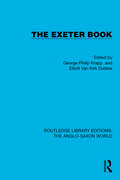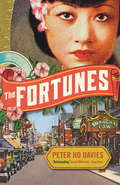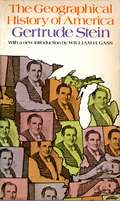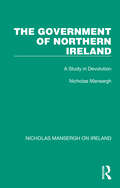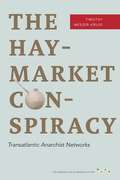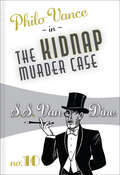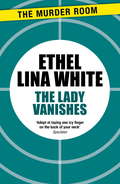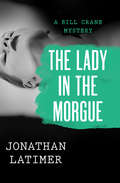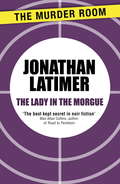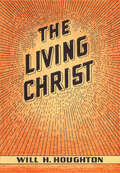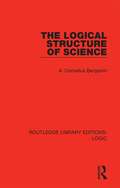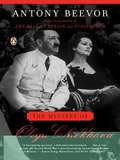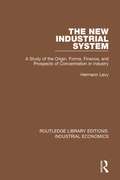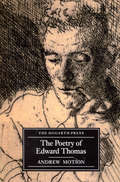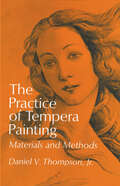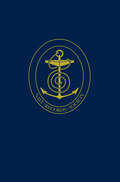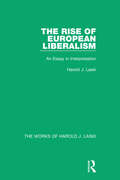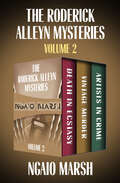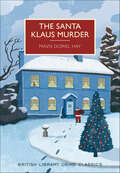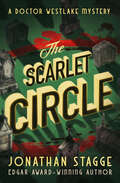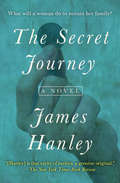- Table View
- List View
The Exeter Book (Routledge Library Editions: The Anglo-Saxon World #9)
by George Philip KrappThe Exeter Book (1936) contains the texts of the Exeter Book, the largest of the great miscellanies of Anglo-Saxon poetry, together with an extensive introduction and notes.
The Fortunes
by Peter Ho DaviesAh Ling: son of a prostitute and a white 'ghost', dispatched from Hong Kong as a boy to make his way alone in 1860s California. Anna Mae Wong: the first Chinese film star in Hollywood, forbidden to kiss a white man on screen. Vincent Chin: killed by a pair of Detroit auto workers in 1982 simply for looking Japanese.John Ling Smith: a half-Chinese writer visiting China for the first time, to adopt a baby girl.Inspired by three figures who lived at pivotal moments in Chinese-American history, and drawing on his own mixed-race experience, Peter Ho Davies plunges us into what it is like to feel, and be treated, like a foreigner in the country you call home.Ranging from the mouth of the Pearl River to the land of golden opportunity, this remarkable novel spans 150 years to tell a tale of familial bonds denied and fragmented, of tenacity and pride, of prejudice and the universal need to belong.
The Geographical History of America: or the Relation of Human Nature to the Human Mind
by Gertrude Stein"First published in 1936 and long out of print, The Geographical History of America brings together prose pieces, dialogues, philosophical meditations, and playlets by one of the century's most influential experimental writers. This short but brilliant book offers a dimension of Gertrude Stein's thinking not available elsewhere. Here Stein sets forth her view of the human mind: what it is, how it works, and how it is different from - and more interesting than - human nature. " "Geographical History also elaborates on Stein's concepts of identity, landscape, presence, and composition. Today, as literary discourse pays more attention to textuality, to voice, reader-response, and phenomenology, Stein emerges as a pioneering modernist to whom the century is slowly catching up. For those in the performing arts, Geographical History further addresses the notion of play as landscape, one of Stein's most influential theatrical ideas, as well as such issues as dialogue, character, and dramatic structure - in a book that is itself a model of modern experimentation. "--BOOK JACKET. Title Summary field provided by Blackwell North America, Inc. All Rights Reserved
The Government of Northern Ireland: A Study in Devolution
by Nicholas ManserghOriginally published in 1936, The Government of Northern Ireland examines the practical operation of devolution which was granted to Northern Ireland in 1920. The later phases of the Ulster Question, interacting with a theoretic conception of devolution, provide the historical background in the light of which early 20th Century government in Ireland is analysed. The political, administrative and financial relations between the (then Imperial) and subordinate Parliament, the powers and personnel of the local legislature and the character of the local government are all discussed. The achievement of self-government in Northern Ireland is summarized with special regard to the desirability of a similar grant of devolution to Scotland and Wales.
The Haymarket Conspiracy: Transatlantic Anarchist Networks
by Timothy Messer-KruseThe Haymarket Conspiracy: Transatlantic Anarchist Networks traces the evolution of revolutionary anarchist ideas in Europe and their migration to the United States in the 1880s. A new history of the transatlantic origins of American anarchism, this study thoroughly debunks the dominant narrative through which most historians interpret the Haymarket Bombing and Trial of 1886-87. Challenging the view that there was no evidence connecting the eight convicted workers to the bomb throwing at the Haymarket rally, Timothy Messer-Kruse examines police investigations and trial proceedings that reveal the hidden transatlantic networks, the violent subculture, and the misunderstood beliefs of Gilded Age anarchists. Messer-Kruse documents how, in the 1880s, radicals on both sides of the Atlantic came to celebrate armed struggle as the one true way forward and began to prepare seriously for conflict. Within this milieu, he suggests the possibility of a "Haymarket conspiracy": a coordinated plan of attack in which the oft-martyred Haymarket radicals in fact posed a real threat to public order and safety. Drawing on new, never-before published historical evidence, The Haymarket Conspiracy provides a new means of understanding the revolutionary anarchist movement on its own terms rather than in the romantic ways in which its agents have been eulogized.
The Kidnap Murder Case: Philo Vance #10 (Philo Vance)
by S.S. Van DineWhen a playboy is abducted, the highly educated detective “reveals himself as a gun-fighter who can pump hot lead with the best of them” (The New York Times).Recently returned from a refreshing sojourn in Egypt and on his way out the door to enjoy a dog show, Philo Vance is stopped in his tracks by a visit from the New York district attorney. Notorious gambler and ne’er-do-well Kaspar Kenting has been kidnapped from his uptown home, and the culprits are demanding that the fifty-thousand-dollar ransom be left inside a hollow tree at midnight. But things don’t go well—and the sophisticated and aristocratic detective is about to pick up a pistol and get down in the muck with some very unpleasant characters in this witty, suspenseful Golden Age mystery classic.“Mr. Van Dine’s amateur detective is the most gentlemanly, and probably the most scholarly snooper in literature.” —Chicago Daily Tribune
The Lady Vanishes
by Ethel Lina WhiteThe exciting original of the Hitchcock film classic.Iris Carr was young, wealthy, attractive - and bored. Despairing of her society friends, tired of skiing with the crowd, she decides to return to England alone by train. But she hadn't bargained for the extraordinary Miss Froy - a lively, gossipy spinster who is determined to befriend her, nor had she expected Miss Froy's sudden disappearance.Certain that she has not imagined so bizarre a character, and outraged by the blank faces of the passengers who deny her existence, Iris vows to find her companion, unaware of the terrifying trail ahead, so wildly different from her notion of a comfortable journey home.
The Lady Vanishes (Murder Room #669)
by Ethel Lina WhiteThe exciting original of the Hitchcock film classic.Iris Carr was young, wealthy, attractive - and bored. Despairing of her society friends, tired of skiing with the crowd, she decides to return to England alone by train. But she hadn't bargained for the extraordinary Miss Froy - a lively, gossipy spinster who is determined to befriend her, nor had she expected Miss Froy's sudden disappearance.Certain that she has not imagined so bizarre a character, and outraged by the blank faces of the passengers who deny her existence, Iris vows to find her companion, unaware of the terrifying trail ahead, so wildly different from her notion of a comfortable journey home.
The Lady in the Morgue (The Bill Crane Mysteries #3)
by Jonathan LatimerA vanished corpse leads a hard-drinking PI on a madcap chaseMore than forty corpses fill the cold Chicago basement, but no crime has been committed here. After all, there are supposed to be bodies in the city morgue. Tonight, one is attracting particular attention: a beautiful young woman whose apparent suicide captured the imagination of every newspaper editor in town. Learning how and why she died is too great a task for any cub reporter. Only Detective Bill Crane is up to the job.A few minutes after Crane wakes from a nap in the morgue, the mysterious woman&’s body has disappeared. With the howls of the mental patients as a soundtrack, Crane leads the police on a wild search through the hospital and across Chicago, stopping for a nap or a cocktail whenever the situation demands. It may be a matter of life and death, but that is no reason to rush.
The Lady in the Morgue (The\bill Crane Mysteries Ser. #3)
by Jonathan LatimerOne reviewer referred to the well-loved third novel in Latimer's Bill Crane series as 'rough, rowdy and rum-soaked'. And true to form, just as in his previous investigations, Crane drinks his way through his current case, that of a young suicide whose body disappears just as Crane arrives on the scene. But is there any connection between this body, and the disappearance of a young woman from a wealthy New York family? In order to retrieve the missing body, and find the murderer, Crane must run the gauntlet of both local cops and gangsters, who believe he is implicated. As well as a fascinating mystery, The Lady in the Morgue is packed full of atmosphere and period detail, from its opening scene in a morgue to its frank treatment of drug addiction and references to contemporary music.
The Living Christ: And Other Gospel Messages
by Will H HoughtonNine important messages, written in the author's friendly style, are embraced in this volume. The title of the book is taken from the first message, which is of such great import in these days when so many are worshipping a dead Christ. The Living Christ has a vital appeal to the young as well as to the old. It emphasizes the need and the way of salvation. In the chapter entitled "Your Permanent Writing," the author stresses the importance of character, showing how character is formed by habits--good or bad--and becomes permanent. Some day it will be revealed! Dr. Houghton turns the "Stop Light" across life's pathway, for he is a friend of young people, and points them the better way.
The Living Christ: And Other Gospel Messages
by Will H HoughtonNine important messages, written in the author's friendly style, are embraced in this volume. The title of the book is taken from the first message, which is of such great import in these days when so many are worshipping a dead Christ. The Living Christ has a vital appeal to the young as well as to the old. It emphasizes the need and the way of salvation. In the chapter entitled "Your Permanent Writing," the author stresses the importance of character, showing how character is formed by habits--good or bad--and becomes permanent. Some day it will be revealed! Dr. Houghton turns the "Stop Light" across life's pathway, for he is a friend of young people, and points them the better way.
The Logical Structure of Science (Routledge Library Editions: Logic)
by A. Cornelius BenjaminThis book addresses the argument in the history of the philosophy of science between the positivists and the anti-positivists. The author starts from a point of firm conviction that all science and philosophy must start with the given… But that the range of the given is not definite. He begins with an examination of science from the outside and then the inside, explaining his position on metaphysics and attempts to formulate the character of operational acts before a general theory of symbolism is explored. The last five chapters constitute a treatise to show that the development from one stage of symbolismto the next is inevitable, consequently that explanatory science represents the culmination of knowledge.
The Mystery of Olga Chekhova
by Antony BeevorAntony Beevor's The Mystery of Olga Chekhova is the true story of a family torn apart by revolution and war. Olga Chekhova was a stunning Russian beauty and a famous Nazi-era film actress who Hitler counted among his friends; she was also the niece of Anton Chekhov. After fleeing Bolshevik Moscow for Berlin in 1920, she was recruited by her composer brother Lev, to work for Soviet intelligence. In return, her family were allowed to join her. The extraordinary story of how the whole family survived the Russian Revolution, the civil war, the rise of Hitler, the Stalinist Terror, and the Nazi invasion of the Soviet Union becomes, in Antony Beevor's hands, a breathtaking tale of compromise and survival in a merciless age. 'A fascinating spy story, a delicious entertainment, a compelling investigation' Evening Standard'An extraordinary drama of exile and espionage' Independent'Compelling . . . as engaging a read as Stalingrad and Berlin' GuardianAntony Beevor is the renowned author of Stalingrad, which won the Samuel Johnson Prize, the Wolfson Prize for History and the Hawthornden Prize for Literature, and Berlin, which received the first Longman-History Today Trustees' Award. His books have sold nearly four million copies.
The New Industrial System: A Study of the Origin, Forms, Finance, and Prospects of Concentration in Industry (Routledge Library Editions: Industrial Economics #20)
by Hermann LevyThis book, first published in 1936, analyses the then-recent phenomenon of industrial combination. Concentration was new. Industrial combination was new. The interlocking of finances was new. The role of banks in regard to industry was new. The domination of financial capital over large sectors of industry was new. The author examines the new industrial system as it was, on the cusp of new world-economic conditions, resulting from and manifesting themselves in a revolution in transport, the creation of concentrated mass supply and mass demand, changes in the distribution of raw material supplies and the adaption of the technical and economic structure of the industrial unit to these new conditions.
The Panzer III: Hitler's Beast of Burden (Images of War)
by Anthony Tucker-JonesThe Panzerkampfwagen III Panzer III was one of the German army's principal tanks of the Second World War, yet its history is often overlooked in comparison to its more famous successors the Panzer IV, Panther and Tiger. Anthony Tucker-Jones, in this volume in the Images of War series, provides a visual account of the tank in over 150 wartime photographs and describes in a concise text its development and operational history. The Panzer III was designed as part of Hitler's re-armarment program in the mid-1930's and played a key role in the German blitzkrieg offensives in Poland, France and the Soviet Union. Although it lacked adequate firepower and could not match more advanced Allied tanks like the T-34, it stayed in service in North Africa and on the Eastern Front and it was still encountered in action in Normandy towards the end of the war. Its reliable chassis was also adapted for assault gun production. In this form, as the Sturmgeschtz III, it took part in the defensive battles fought by the Wehrmacht as it retreated in Italy, France and eastern Europe. Anthony Tucker-Jones's selection of photographs show the Panzer III in every theater of the war and at every stage, and his text gives an insight into the design history and fighting performance of this historic armored vehicle.
The Poetry Of Edward Thomas
by Andrew MotionWhen Edward Thomas died at Arras in 1917 few people thought of him as a poet. Yet in the two years before his death, after a lifetime writing prose, Thomas wrote some of the most enduring poems of his day: poems of war, nature, friendship, despair and exultation. Andrew Motion's pioneering study of Thomas' life and achievement is scholarly yet utterly absorbing, combining an account of his struggles as a writer with perceptive readings of individual poems.Andrew Motion's books include a biography, The Lamberts, George, Constant and Kil, and several prize-winning collections of poetry, the most recent of which is Love in a Life. He is currently writing the authorized biography of Philip Larkin.
The Practice of Tempera Painting: Materials and Methods (Dover Art Instruction)
by Daniel V. ThompsonTempera painting, the method in which colors are mixed with some binding material other than oil (primarily egg yolk), is the earliest type of painting known to man. The wall paintings of ancient Egypt and Babylon are tempera, as are many of the paintings of Giotto, Lippi, Botticelli, Raphael, Titian, Tintoretto, and many other masters. But in spite of the time-proven excellence of this technique -- which boasts many clear advantages over oil paint -- it does not receive the degree of attention from modern painters that it deserves.Part of the explanation for this neglect, surely, is the absence of sufficient information about the materials and procedures involved in tempera painting. The present volume, in fact, is virtually the only complete, authoritative, step-by-step treatment of the subject in the English language, D.V. Thompson wrote this book after an exhaustive study, over many years, of countless medieval and Renaissance manuscripts in the British Museum and elsewhere, and is unquestionably the world's leading authority on tempera materials and processes.Beginning with an introductory chapter on the uses and limitations of tempera, the author covers such topics as the choice of material for the panel; propensities of various woods; preparing the panel for gilding; making the gesso mixture; methods of applying the gesso; planning the design of a tempera painting; use of tinted papers; application of metals to the panel; tools for gliding; handling and laying gold; combination gold and silver leafing; pigments and brushes; choice of palette; mixing the tempera; tempering and handling the colors; techniques of the actual painting; mordant gilding; permanence of tempera painting; varnishing; and artificial emulsion painting. The drawings and diagrams, illustrating the various materials and techniques, infinitely increase the clarity of the discussions. As a careful exposition of all aspects of authentic tempera painting, including many of the possible modern uses for this ancient method, this book actually stands alone. No one who is interested in tempera painting as a serious pursuit can afford to be without it.
The Private Papers of John, Earl of Sandwich: 1771-1782, Vol. III
by G.R. Barnes J.H. OwenThe Fourth Earl of Sandwich was First Lord of the Admiralty (for the third time in his long career) from 1771 to 1782. Blamed by the Whig opposition for many of the disasters of the American War, he was additionally loaded by 19th-century Whig historians with the false image of a corrupt libertine.It was the publication of these volumes of his correspondence and papers (then in the family home, now in the National Maritime Museum), covering the years 1771 to 1782, which restored his reputation as a conscientious and imaginative naval administrator and reformer, especially of the dockyards and of the timber question. Without entirely rescuing his status as a strategist, they showed very clearly the weaknesses at the heart of the North administration which damaged its handling of the war, and undermined Sandwich’s efforts.A fifth volume intended to cover his handling of naval patronage was overtaken by the war.This volume is from May 1779 to December 1780.
The Republican Army in the Spanish Civil War, 1936-1939
by Michael AlpertThis is a long-awaited translation of a definitive account of the Republican Army in the Spanish Civil War. Michael Alpert examines the origins, formation and performance of the Republican Army and sets the Spanish Civil War in its broader military context. He explores the conflicts between communists and Spanish anarchists about how the war should be fought, as well as the experience of individual conscripts, problems of food, clothing and arms, and the role of women in the new army. The book contains extensive discussion of international aspects, particularly the role of the International Brigades and of the Soviet Russian advisers. Finally, it discusses the final uprising of professional Republican officers against the Government and the almost unconditional surrender to Franco. Professor Alpert also provides detailed statistics for the military forces available to Franco and to the Republic and biographies of the key figures on both sides.
The Rise of European Liberalism: An Essay in Interpretation (The Works of Harold J. Laski)
by Harold J. LaskiA valuable piece of intellectual history, readable in its own terms, this volume, beginning with the Renaissance and the Reformation, traces the growth of Liberal doctrine until the advent of the French Revolution. It shows the relation of Liberalism to the new economic system, and the impact of this upon science, philosophy and literature. The book explains how the same causes which produced the Liberal spirit also produced the reasons for the growth of Socialism.
The Roderick Alleyn Mysteries Volume 2: Death in Ecstasy, Vintage Murder, Artists in Crime (Roderick Alleyn)
by Ngaio MarshThree compelling tales of crime featuring the sharp-witted British police detective: &“Any Ngaio Marsh story is certain to be Grade A.&” —The New York Times This volume includes three books in the classic detective series from the Mystery Writers of America Grand Master: Death in Ecstasy: Tainted wine sends a member of a religious sect to meet her maker in a witty mystery marked by &“quiet, intelligent deduction&” (Kirkus Reviews). Vintage Murder: Inspector Alleyn is enjoying his trip to New Zealand—until intrigue among his fellow travelers turns deadly . . . Artists in Crime: An artists&’ model is murdered—and among the suspects is a new woman in Inspector Alleyn&’s life—in this &“first-rate&” detective story (Kirkus Reviews).
The Santa Klaus Murder: A British Library Crime Classic (British Library Crime Classics #0)
by Mavis Doriel HayMystery crime fiction written in the Golden Age of Murder"Despite its title, this British Library Crime Classics reissue of a 1936 novel isn't just an entertaining Christmas read. It's a fine example of the old-time country-house murder mystery, with loads of suspects, lots of period atmosphere, and much caustic wit." —BooklistAunt Mildred declared that no good could come of the Melbury family Christmas gatherings at their country residence Flaxmere. So when Sir Osmond Melbury, the family patriarch, is discovered—by a guest dressed as Santa Klaus—with a bullet in his head on Christmas Day, the festivities are plunged into chaos. Nearly every member of the party stands to reap some sort of benefit from Sir Osmond's death, but Santa Klaus, the one person who seems to have every opportunity to fire the shot, has no apparent motive. Various members of the family have their private suspicions about the identity of the murderer, and the Chief Constable of Haulmshire, who begins his investigations by saying that he knows the family too well and that is his difficulty, wishes before long that he understood them better. In the midst of mistrust, suspicion and hatred, it emerges that there was not one Santa Klaus, but two.
The Scarlet Circle (The Doctor Westlake Mysteries #6)
by Jonathan StaggeA Golden Age mystery featuring a sleuthing small-town doctor who&’s out of his depth as a killer haunts a waning New England summer. On vacation with his daughter on the New England coast, Dr. Hugh Westlake is enjoying the sun, the sea, and the fishing. Being September, the inn where they&’re staying is almost empty, except for a few other guests. But the peace is shattered when a woman&’s body is found strangled on the beach, with a red circle drawn around a mole on her face. The morbid scene becomes more so when she&’s identified as the governess of a family staying at the inn. Hugh gets drafted by local law enforcement to help with the investigation. He uncovers dysfunctional parents, a creepy mortician, a handsome lifeguard, and a woman painter—all with secrets to hide. Not to mention local legends. When another woman is murdered, with another mole circled, Hugh realizes there&’s a madman on the loose. And he must tie up the loose ends of crimes past and present to net a most diabolical killer. &“Stagge has packed some excellent reading between the opening and closing chapters.&” —Chicago Sun &“An exciting and grisly yarn.&” —New York Herald Tribune &“A fine entry in one of the better American amateur detective novel series.&” —Pretty Sinister Books &“One of the year&’s supreme morsels. It has everything the exemplary detective story should possess.&” —Worcester Telegram
The Secret Journey: A Novel (The Furys Saga #2)
by James HanleyTo sustain her family, Mrs. Fury buries herself in debt At the top of the hill on the north side of town, Mrs. Ragner rules over her kingdom. A bitter old loan shark, she has a grip on all the families in this port city, and she squeezes each one for every last cent. For seven years, Mrs. Fury has borrowed money from Mrs. Ragner to send her son Peter to seminary. He never joined the priesthood, but the debt still stands. When she is unable to pay back her loan, Mrs. Ragner is happy to extend more credit. But every time they revisit their agreement, the interest rate rises and Mrs. Ragner&’s stranglehold on the Furys tightens. While his mother struggles to pay back her debts, Peter tries to find his way in the secular world. He is deeply in love with his older brother&’s wife, and his passion threatens to upend the family. The Furys think they have sacrificed everything for Peter, but they are not done yet. The Secret Journey is the second book of James Hanley&’s acclaimed Furys Saga.
